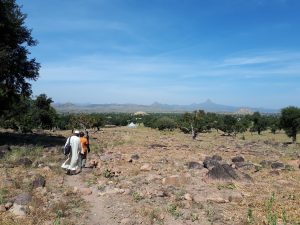Documentation of Kushi, a Chadic language of Northern Nigeria

Landing page image for the collection “Documentation of Kushi, a Chadic language of Northern Nigeria”. Click on image to access collection.
| Language | Kushi (ISO639-3:kuh), |
| Depositor | Gian Claudio Batic |
| Affiliation | Università degli Studi di Napoli “L’Orientale” |
| Location | Nigeria |
| Collection ID | |
| Grant ID | SG0573 |
| Funding Body | ELDP |
| Collection Status | Collection online |
| Landing Page Handle | http://hdl.handle.net/2196/44626cf1-cd6f-44d4-8872-2a85c675b3ed |
Summary of the collection
Kushi is spoken in the so-called ‘Kushi village area’, a series of hamlets on the northeastern fringes of the Muri mountains (Gombe State, Shongom LGA). This collection includes audiovisual material documenting different kinds of language use: storytelling, autobiographical narrations, procedural texts, and conversations.
Part of the audiovisual material is annotated and fully glossed.
Group represented
The project deals with the language spoken by the Kushi, a Chadic-speaking group settled in the southern Gongola river basin. Kushi are predominantly Muslim, with Christian adherents representing an important component of the community. Traditional beliefs are still practiced in a more or less open way (even if less frequently) by both Muslims and Christians. The Gongola river basin is home to a constellation of ethnic groups sharing an agriculturalist tradition dating back at least to the 1000 BCE. Kushi rely on a subsistence economy based essentially on farming; their eating habits are shaped by the food production system and do not differ significantly from those of the other groups inhabiting the region. Groups living in rural areas display ‘traditional’ eating habits based on the consumption of food rich in carbohydrates and fibres and poor in proteins. According to the oral tradition, the Kushi were originally from the Kanuri dominated region of Borno. They migrated to Gwana, in Pindiga area (south-west of Gombe), where they lived peacefully until a war broke out between the Pindiga and other unidentified groups. The Kushi, seeing that the conflict was intensifying, decided to leave Gwana and moved to several other places (such as Korash, Shonghlo, Damok, Yame, Benye, Dara, and Burak) to finally settle on the slopes of the Chonge-Mona range. It was there that they found the Fojorak, an autochthonous group usually described as ‘a people of light complexion living in caves’. The reasons given for abandoning all of these places and finally migrating to Kushi are related to the lack of fertile land and scarcity of water. Kushi people and their movements as recorded in oral traditions should be interpreted as a synthetic representation of a series of numerous migrations to the northern uphills of the Chonge-Mona undertaken by different groups living in the area, and not by a single Kushi group migrated from Borno.
Language information
Kushi is a Chadic language (West Chadic, A.2, Bole-Tangale, Tangale proper) spoken on the northeastern fringe of the Muri mountains (Nigeria, Gombe State, Chonge District, Shongom LGA). The Kushi ‘village area’ encompasses the hamlets of Kauri and Kommo (westwards) and Dirang and Gomle (eastwards). The Kushi of Gomle and Dirang is considered more conservative and closer to the language spoken by the ancestors, whereas the Kushi spoken in Kauri and Kommo is seen as more exposed to phonetic change and lexical borrowing (mainly from Hausa and Pero). The number of Kushi speakers is around 11,000.
Kushi is a SVO/VSO language displaying several features resulting from a long-term contact with non-Chadic speaking groups (e.g. Jukunoid and Waja-Jen languages). Among these features, an inflated consonant inventory (37 phonemes), a large vowel inventory (10 vowels working in a system of [±ATR] harmony), and the presence of a partial logophoric system. The language has a simple tone system (two-way contrast) and a moderately complex syllabic system (CV, CVC, CVV, and CVVC). Kushi shares with other south Bole-Tangale languages a certain number of features: intransitive copy pronouns, gender neutralisation (i.e. feminine as the default gender), and development of verbal derivations to mark pluractionality. TAMs are encoded through verbal inflection and satellite markers.
Despite being the language used by the inhabitants of the village area in everyday linguistic exchange, Kushi faces the challenge given by the presence and the pressure exerted by Hausa, the lingua franca of the region. The community is already bilingual and the increasing use of the vehicular language is affecting the lexical and grammatical competence of the younger generations of Kushi speakers. This is evident, for example, in the domestic sphere where Hausa is slowly replacing Kushi, or also in the lexico-grammatical choices of the speakers: Hausa words are used instead of the equivalent Kushi item and entire sections of verbal morphology (i.e. pluractionals) are fading away and are virtually no longer in use. This process of erosion is somehow mirrored in the oral tradition: the knowledge of Kushi proverbs and folktales is shifting towards the grand-parental generation, which means that the intergenerational transmission chain of oral tradition is partly broken.
Collection contents
The majority of bundles in this collection are audio and audio-video recordings.
Acknowledgement and citation
Users of any part of the collection should acknowledge Gian Claudio Batic as the data collector and researcher. Users should also acknowledge the Endangered Languages Documentation Programme as the funder of the project. Individual speakers whose utterances and/or images are used should be acknowledged by name. Any other contributor who has collected, transcribed or translated the data or was involved in any other way should be acknowledged by name. All information on contributors is available in the metadata.
Batic, Gian C. 2019. Documentation of Kushi, a Chadic language of Northern Nigeria. Endangered Languages Archive. http://hdl.handle.net/2196/0acac49a-78bd-43a1-80e7-2e6e4d420845. Accessed on [insert date here]


